Analys
Comfort zone for OPEC+ in 2024 as fundamentals gradually improve in its favor
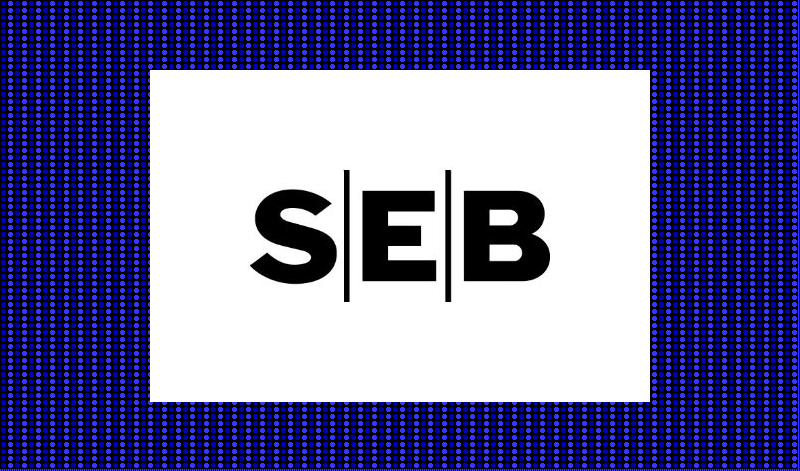
Back to its sideways trade range and inching almost unnoticeable higher as the year progresses. Brent crude is up 0.2% this morning to USD 82.7/b along with copper (+0.3%) and Shanghai equities (+1.0%). Brent crude saw some bearish action at the end of last week but it recovered a good portion of that ydy (+1.1%) and then a little more again this morning. With this it has mostly returned back to its sideways trading pattern.

Brent crude averaged USD 79.1/b in January. So far in February it has averaged USD 81.5/b and at the moment it trades at USD 82.7/b. Typical market comments these days are along the theme ”looking for direction” or ”waiting for new signals on supply or demand”. But other comments are more attuned to a view that the direction is indeed sideways this year. Argus last week describe the outlook for the supply/demand balance for 2024 as ”almost perfectly aligned” and Goldman adds to this view in a note yesterday with ”oil set to extend its tight trading range”.
Cease-fire in Gaza on Monday 4 March may create a buying opportunity. News this morning is Biden expressing hopes that a cease-fire in Gaza may start as soon as Monday next week. In our view there is basically zero risk premium in the current oil price due to Middle East tensions. So if the oil price sells off on firm news of a cease-fire, then it is probably a good buying opportunity in our view.
We maintain our strong view of an average Brent crude oil price of USD 85/b in 2024. Total US crude and product stocks including SPR has gone flat sideways since the end of 2022, all through 2023 and has continued to do so in 2023. US oil inventories are below where they were one year ago both when SPR is included and excluded. This is a reflection of a global oil market in balance though OPEC+ has indeed been the balancing agent.
For the year to come, total US hydrocarbon liquids production is forecast by the US EIA to go flat sideways until October this year and in Q4-24 US production is forecast to be only 0.1 m b/d above Q4-23. So no damaging super-growth from the US to kill the oil party this year. In its last monthly report the US EIA actually reduced its forecast for US production by 100 k b/d to 22.3 m b/d (all liquids included). Russia’s energy minister, Nikolay Shulginov, stated in Tass news agency recently that he expects Russian oil production to decline to 530 mn ton in 2024 from 523 mn ton in 2023. That’s a decline of 1.3% YoY and would equate to a decline of 120-130 k b/d decline YoY. So neither of these oil producing giants are set to unsettle the global oil market this year with too much supply.
Demand growth looks set to be a normal 1.3 m b/d in 2024. The most bearish on oil demand growth is probably the IEA which predicts demand to grow on by 1.2 m b/d YoY in 2024. The US EIA expects demand to grow by 1.4 m b/d. But if we look closer at the numbers from the IEA it expects demand to rise by 1.6 m b/d YoY from Q4-23 to Q4-24. Together with muted supply from both the US and Russia this year this all sums up to a gradually rising need for oil from OPEC through 2024. This made us write the headline ”Better and better every day” in a crude oil comment in late January. Demand for oil from OPEC doesn’t look stellar. But it looks set to be better and better through the year and that is most definitely a great comfort zone for OPEC+.
Sideways, yes, but normal trade range around the mean is still usually +/- USD 20/b. Amid all the current calmness, let us still not forget that Brent crude usually trades in a range through the year of +/- USD 20/b around the mean as there are always some surprises along the way. We don’t think that the situation in the Middle East will spiral out of control into an all-out regional war involving Iran and resulting in large losses of oil supply to the market. And we don’t think there are much risk premium in current oil prices related to this either. But at times in 2024 it may look like it might happen. And that’s probably when you would see the high price point of the year. Maybe as high as USD 105/b. On the bearish we do not think that we’ll have a major economic slowdown or a recession in 2024. But at times in 2024 it may look like we are about to tip into a major slowdown and that would probably be when you’d see the low price point of the year. Maybe as low as USD 65/b.
Total US crude and product stocks incl. SPR has gone sideways since end of 2022, all through 2023 and so far in 2024. Currently it is only 13 m b above the low-point in late 2022!
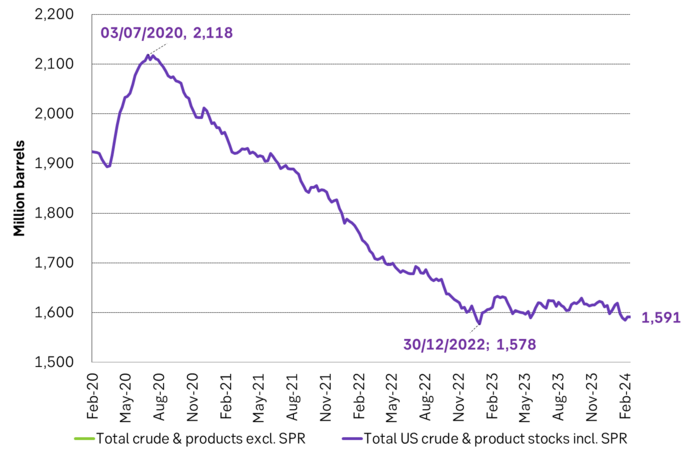
Commercial US crude and product stocks are below normal and below last year.
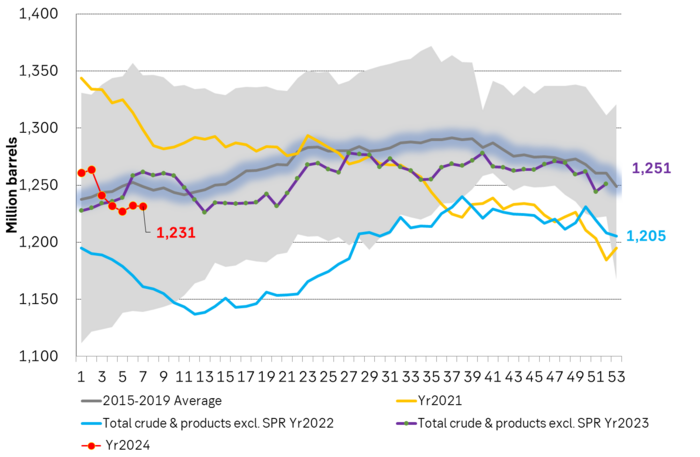
US Commercial oil inventories vs. the 2015-19 average. Still struggling with a significant deficit of middle distillates.
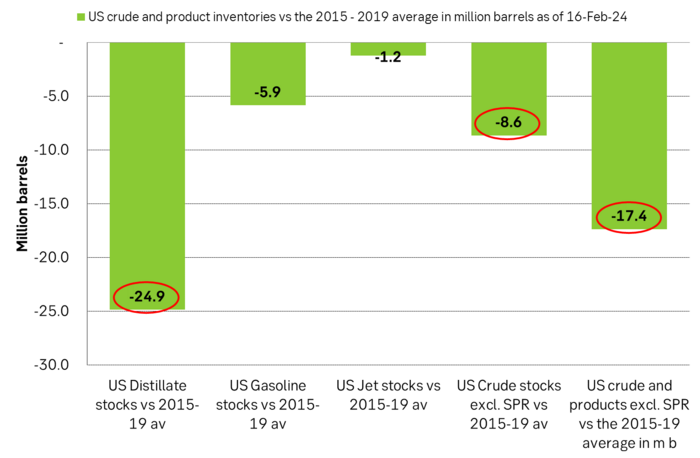
US refinery utilization at very low level vs. normal. Extensive maintenance this spring is expected. Result will be low production of oil products, falling inventories of oil products, higher refining margins but also rising crude stocks.
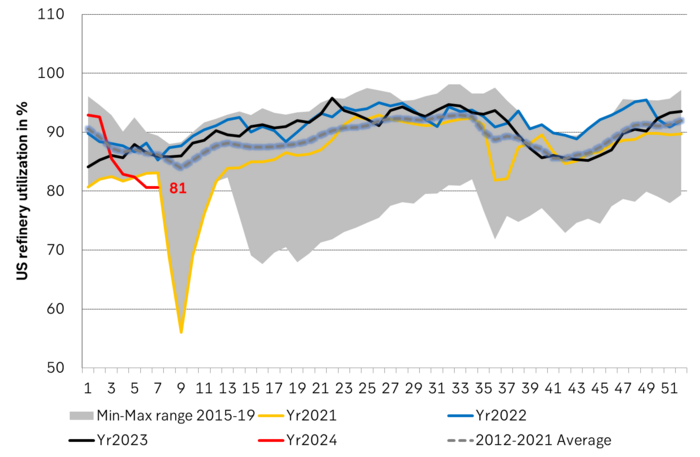
US EIA forecast for total US liquids production. To go sideways in 2024 to Oct-2024.
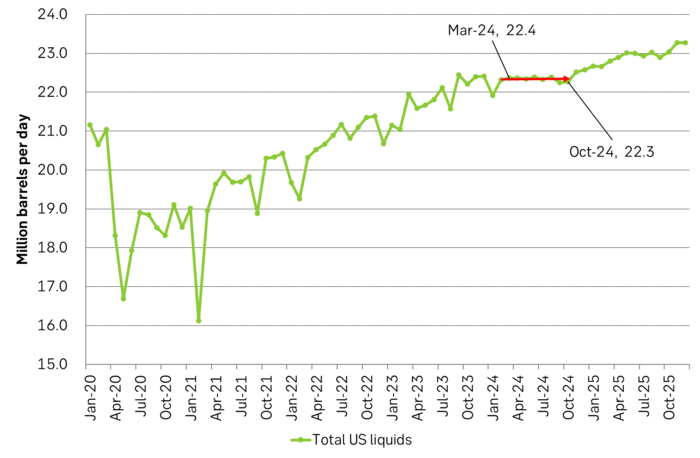
Strong growth in US supply in 2022 and 2023. But 2024 is only set to grow 0.5 m b/d YoY on average. The growth in 2024 is in part a result of production in 2023 starting low and ending high. But from Jan to Oct 2024 US production will go sideways and only rise by 0.1 m b/d YoY from Q4-23 to Q4-24.
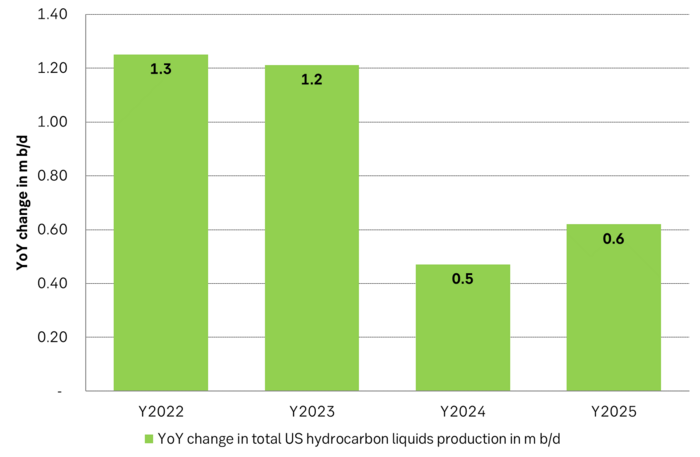
Global floating crude stocks at 66 m b and not too far above the more normal 50 m b level.
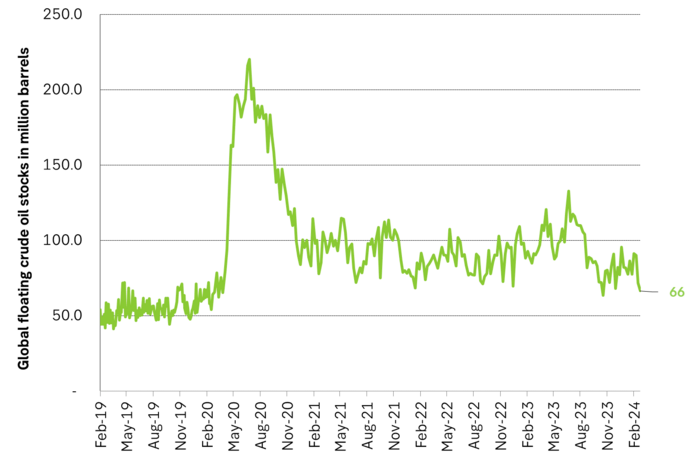
IEA Feb-2024 OMR: Call-on-OPEC is rising gradually through 2024. Better and better for OPEC every quarter to Q3-24
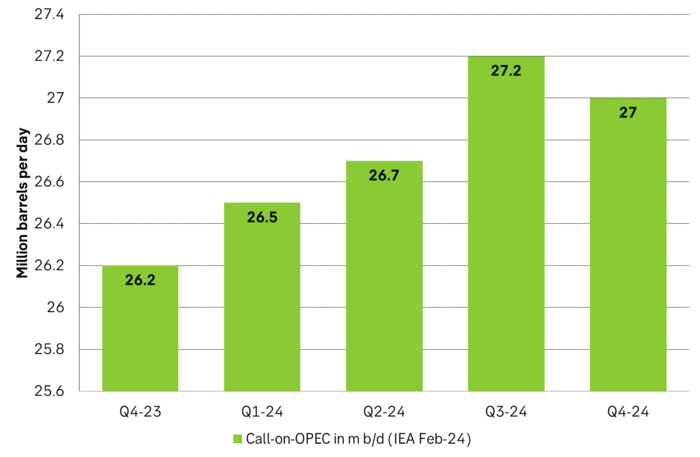
Analys
Tightening fundamentals – bullish inventories from DOE

The latest weekly report from the US DOE showed a substantial drawdown across key petroleum categories, adding more upside potential to the fundamental picture.

Commercial crude inventories (excl. SPR) fell by 5.8 million barrels, bringing total inventories down to 415.1 million barrels. Now sitting 11% below the five-year seasonal norm and placed in the lowest 2015-2022 range (see picture below).
Product inventories also tightened further last week. Gasoline inventories declined by 2.1 million barrels, with reductions seen in both finished gasoline and blending components. Current gasoline levels are about 3% below the five-year average for this time of year.
Among products, the most notable move came in diesel, where inventories dropped by almost 4.1 million barrels, deepening the deficit to around 20% below seasonal norms – continuing to underscore the persistent supply tightness in diesel markets.
The only area of inventory growth was in propane/propylene, which posted a significant 5.1-million-barrel build and now stands 9% above the five-year average.
Total commercial petroleum inventories (crude plus refined products) declined by 4.2 million barrels on the week, reinforcing the overall tightening of US crude and products.
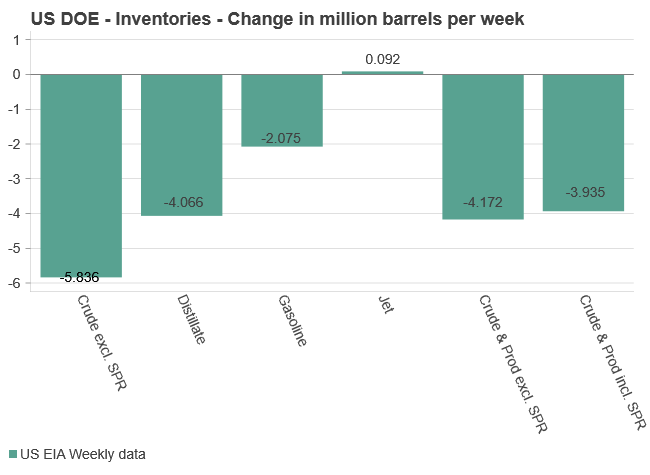
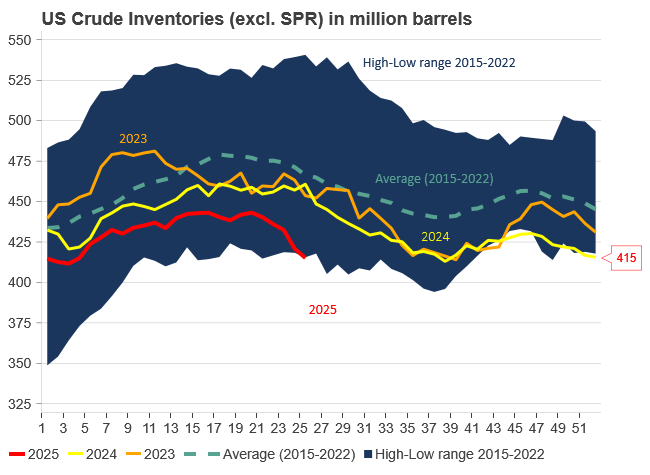
Analys
Bombs to ”ceasefire” in hours – Brent below $70

A classic case of “buy the rumor, sell the news” played out in oil markets, as Brent crude has dropped sharply – down nearly USD 10 per barrel since yesterday evening – following Iran’s retaliatory strike on a U.S. air base in Qatar. The immediate reaction was: “That was it?” The strike followed a carefully calibrated, non-escalatory playbook, avoiding direct threats to energy infrastructure or disruption of shipping through the Strait of Hormuz – thus calming worst-case fears.

After Monday morning’s sharp spike to USD 81.4 per barrel, triggered by the U.S. bombing of Iranian nuclear facilities, oil prices drifted sideways in anticipation of a potential Iranian response. That response came with advance warning and caused limited physical damage. Early this morning, both the U.S. President and Iranian state media announced a ceasefire, effectively placing a lid on the immediate conflict risk – at least for now.
As a result, Brent crude has now fallen by a total of USD 12 from Monday’s peak, currently trading around USD 69 per barrel.
Looking beyond geopolitics, the market will now shift its focus to the upcoming OPEC+ meeting in early July. Saudi Arabia’s decision to increase output earlier this year – despite falling prices – has drawn renewed attention considering recent developments. Some suggest this was a response to U.S. pressure to offset potential Iranian supply losses.
However, consensus is that the move was driven more by internal OPEC+ dynamics. After years of curbing production to support prices, Riyadh had grown frustrated with quota-busting by several members (notably Kazakhstan). With Saudi Arabia cutting up to 2 million barrels per day – roughly 2% of global supply – returns were diminishing, and the risk of losing market share was rising. The production increase is widely seen as an effort to reassert leadership and restore discipline within the group.
That said, the FT recently stated that, the Saudis remain wary of past missteps. In 2018, Riyadh ramped up output at Trump’s request ahead of Iran sanctions, only to see prices collapse when the U.S. granted broad waivers – triggering oversupply. Officials have reportedly made it clear they don’t intend to repeat that mistake.
The recent visit by President Trump to Saudi Arabia, which included agreements on AI, defense, and nuclear cooperation, suggests a broader strategic alignment. This has fueled speculation about a quiet “pump-for-politics” deal behind recent production moves.
Looking ahead, oil prices have now retraced the entire rally sparked by the June 13 Israel–Iran escalation. This retreat provides more political and policy space for both the U.S. and Saudi Arabia. Specifically, it makes it easier for Riyadh to scale back its three recent production hikes of 411,000 barrels each, potentially returning to more moderate increases of 137,000 barrels for August and September.
In short: with no major loss of Iranian supply to the market, OPEC+ – led by Saudi Arabia – no longer needs to compensate for a disruption that hasn’t materialized, especially not to please the U.S. at the cost of its own market strategy. As the Saudis themselves have signaled, they are unlikely to repeat previous mistakes.
Conclusion: With Brent now in the high USD 60s, buying oil looks fundamentally justified. The geopolitical premium has deflated, but tensions between Israel and Iran remain unresolved – and the risk of missteps and renewed escalation still lingers. In fact, even this morning, reports have emerged of renewed missile fire despite the declared “truce.” The path forward may be calmer – but it is far from stable.
Analys
A muted price reaction. Market looks relaxed, but it is still on edge waiting for what Iran will do

Brent crossed the 80-line this morning but quickly fell back assigning limited probability for Iran choosing to close the Strait of Hormuz. Brent traded in a range of USD 70.56 – 79.04/b last week as the market fluctuated between ”Iran wants a deal” and ”US is about to attack Iran”. At the end of the week though, Donald Trump managed to convince markets (and probably also Iran) that he would make a decision within two weeks. I.e. no imminent attack. Previously when when he has talked about ”making a decision within two weeks” he has often ended up doing nothing in the end. The oil market relaxed as a result and the week ended at USD 77.01/b which is just USD 6/b above the year to date average of USD 71/b.

Brent jumped to USD 81.4/b this morning, the highest since mid-January, but then quickly fell back to a current price of USD 78.2/b which is only up 1.5% versus the close on Friday. As such the market is pricing a fairly low probability that Iran will actually close the Strait of Hormuz. Probably because it will hurt Iranian oil exports as well as the global oil market.
It was however all smoke and mirrors. Deception. The US attacked Iran on Saturday. The attack involved 125 warplanes, submarines and surface warships and 14 bunker buster bombs were dropped on Iranian nuclear sites including Fordow, Natanz and Isfahan. In response the Iranian Parliament voted in support of closing the Strait of Hormuz where some 17 mb of crude and products is transported to the global market every day plus significant volumes of LNG. This is however merely an advise to the Supreme leader Ayatollah Ali Khamenei and the Supreme National Security Council which sits with the final and actual decision.
No supply of oil is lost yet. It is about the risk of Iran closing the Strait of Hormuz or not. So far not a single drop of oil supply has been lost to the global market. The price at the moment is all about the assessed risk of loss of supply. Will Iran choose to choke of the Strait of Hormuz or not? That is the big question. It would be painful for US consumers, for Donald Trump’s voter base, for the global economy but also for Iran and its population which relies on oil exports and income from selling oil out of that Strait as well. As such it is not a no-brainer choice for Iran to close the Strait for oil exports. And looking at the il price this morning it is clear that the oil market doesn’t assign a very high probability of it happening. It is however probably well within the capability of Iran to close the Strait off with rockets, mines, air-drones and possibly sea-drones. Just look at how Ukraine has been able to control and damage the Russian Black Sea fleet.
What to do about the highly enriched uranium which has gone missing? While the US and Israel can celebrate their destruction of Iranian nuclear facilities they are also scratching their heads over what to do with the lost Iranian nuclear material. Iran had 408 kg of highly enriched uranium (IAEA). Almost weapons grade. Enough for some 10 nuclear warheads. It seems to have been transported out of Fordow before the attack this weekend.
The market is still on edge. USD 80-something/b seems sensible while we wait. The oil market reaction to this weekend’s events is very muted so far. The market is still on edge awaiting what Iran will do. Because Iran will do something. But what and when? An oil price of 80-something seems like a sensible level until something do happen.
-

 Nyheter4 veckor sedan
Nyheter4 veckor sedanMahvie Minerals växlar spår – satsar fullt ut på guld
-

 Analys4 veckor sedan
Analys4 veckor sedanA muted price reaction. Market looks relaxed, but it is still on edge waiting for what Iran will do
-

 Nyheter3 veckor sedan
Nyheter3 veckor sedanJonas Lindvall är tillbaka med ett nytt oljebolag, Perthro, som ska börsnoteras
-

 Nyheter3 veckor sedan
Nyheter3 veckor sedanOljan, guldet och marknadens oroande tystnad
-

 Nyheter3 veckor sedan
Nyheter3 veckor sedanDomstolen ger klartecken till Lappland Guldprospektering
-

 Analys3 veckor sedan
Analys3 veckor sedanTightening fundamentals – bullish inventories from DOE
-

 Nyheter2 veckor sedan
Nyheter2 veckor sedanRyska staten siktar på att konfiskera en av landets största guldproducenter
-

 Nyheter2 veckor sedan
Nyheter2 veckor sedanSommarvädret styr elpriset i Sverige







